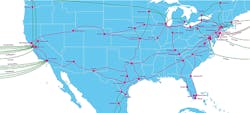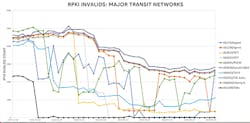8 Telecom Predictions for 2021
At the beginning of 2020, no one could have ever predicted a global pandemic that would sweep across the globe and affect every aspect of our lives. But as COVID-19 spread, there was a rapid and profound change in the way we lived and worked, and how kids learned. Stay-at-home orders resulting from the COVID-19 pandemic had a significant impact on Internet traffic, highlighting the Internet’s essential role as a means for people to stay connected, albeit virtually. By providing the critical foundations of the Internet and enabling the core services that facilitate ubiquitous conferencing, remote working, and e-learning, backbone networks enabled many people to continue their jobs and communicate with friends.
At the beginning of the pandemic, we reported that overall traffic volume rose by around 50% during March 2020 due to pandemic-driven shifts in network usage. Peak traffic levels were up about 35% in certain countries and regions. Some specific client categories, such as videoconferencing, saw their total traffic volume balloon more than 400%. All days of the week looked very similar to what Sundays used to, and near-peak hours were "much more evenly distributed". Hence, there were extended periods of "high utilization and inter-continental overspill".
For the most part, service providers were mostly equipped to increase bandwidth demand on their networks as millions of employees and students became homebound.
Now that 2021 is here, what’s next?
InvisiLight® Solution for Deploying Fiber
April 2, 2022Go to Market Faster. Speed up Network Deployment
April 2, 2022Episode 10: Fiber Optic Closure Specs Explained…
April 1, 2022Food for Thought from Our 2022 ICT Visionaries
April 1, 2022This Year and Beyond
PREDICTION #1: The new norm for remote work and remote learning.
With employers agreeing that many of their employees can work from home (WFH) or from anywhere (WFA), how many will return to the office space once the coronavirus restrictions loosen up across the board?
The Internet’s role, particularly the Internet backbone, plays a critical role more than ever. While a focus on having a robust and secure Internet is critical for 2021, we see other trends for the new year.
From the perspective of the impact of traffic volume increase, the industry needs to simplify how we structure our network domain to make it easier to modularize and expand. There have been actions in that direction.
Automation also gets a kickstart.
In the longer term, we should see the effects of disaggregation of the optical domain to make it more fluid to augment and change the network footprint. More diversity and more redundancy in the footprints are needed.
US Network map.
PREDICTION #2: The role of the edge becomes more important.
Once 5G services permeate the market, we see several new players entering the edge game. The current mobile network operators are challenged by several companies that want to offer their services at its very edge.
Additionally, the reality of where the edge truly lies continues to be a debate in 2021. Although these new distributed edges are designed for low latency applications, they still create enormous amounts of data that end up being transported to larger, centralized cloud or storage facilities away from the edge.
PREDICTION #3: There is a continued rise in hybrid networks.
Beyond domestic applications, the increasing reliability of the public Internet during recent years means that it is fast becoming a compelling alternative for business applications. Cloud services have been around for some time in the IT world, but by using the public Internet, these clouds are now much more accessible to everyone. Specific applications still require dedicated cloud access, but the public Internet is increasingly used as a pathway to applications and data storage in the cloud.
Once again, the ubiquity of Internet access — the fact that you can connect from virtually anywhere on the Internet — proves to be a significant driving force behind this change. Instead of avoiding the public Internet, businesses will leverage Software-defined Wide Area Networking (SD-WAN) to enable the public Internet while providing high levels of security and QoS. Known as softwareization, this approach raises network data to increase visibility and share data with applications such as AI and machine learning for network automation and route optimization. Data delivers insights for improved planning and usage, and to resolve issues more rapidly.
RPKI Invalids: Major Transit Networks (January-September 2020)
PREDICTION #4: Network procurement for service providers evolves.
The global COVID-19 pandemic has exposed the fragility of today’s global supply chains and the dangers of just-in-time principles that are designed to keep costs and on-site inventories low. In the future, network buyers need to analyze vendors’ abilities to meet supply and service demands in the face of major disruptive events — deploying strategic sourcing to ensure localized business continuity criteria are integrated into the supply chain.
PREDICTION #5: More around network automation and AI
Automation will get a kick-start, especially the automation of information flows and ways to access information in a completely different manner than what we had previously. The complexity of applications powered by 5G trends, such as IoT, see billions of devices connected to the Internet. This demands smarter network automation from automatic configuration, provisioning, assurance, and orchestration, of services.
We see growing interest in AI-powered zero-touch deployment of networks because they offer a higher degree of automation and less manual intervention.
At the same time, network managers need a complete view of the Big Picture connectivity performance of business-critical applications — to manage key performance metrics and set the baseline for network automation for fault isolation and remediation.
PREDICTION #6: The future of optical is open and disaggregated.
In recent months we saw a significant makeover of global optical network infrastructure to meet the growing demand for high-capacity, low-latency connectivity, unlike anything we have seen in the past. This future jump-starts a new era of network innovation and interoperability that proves transformative for enterprises. Traditionally, the end-to-end optical network was a "closed" proprietary system that was difficult to evolve. But today’s open line technologies have changed the rules of the game: it enables service providers to unbundle their network components and use the best possible combination of hardware and software to enable an era of new and highly flexible networking capabilities.
The past year (2020) saw service providers disaggregate and re-engineer their global optical network for even greater efficiency and agility. Our new open and interoperable network architectures can accommodate different technologies at both platform and component levels, making it possible for service providers to introduce game-changing, best-in-class technologies and infrastructure capabilities at the drop of a hat.
RPKI Invalids: Major Transit Networks (2019-2020)
PREDICTION #7: The security of the Internet remains critical.
Cloud technology and SD-WAN changed the face of networking and had an extraordinary impact on enterprise networking. We saw a steady increase of enterprises relying more on the Public Internet for certain applications, and that trend only increases in 2021. While on-premises solutions, like firewall software protection, still provides one layer of security, it becomes more and more important for Internet backbone providers to increase their security solutions.
Recent attacks on major cloud provider networks have shown that unprotected traffic can be announced to anyone on the Internet, and hackers can highjack network traffic and detour it to unwanted locations. To thwart these attacks, global background providers started to implement (RPKI) Resource Public Key Infrastructure, a mechanism that controls BGP sessions on the Internet, and ensures that a service provider can only announce prefixes it has a right to announce, which provides another layer of security for enterprises. We see RPKI implemented more widely in larger IP networks.
Distributed Denial of Service (DDoS) protection, which provides another layer of security that makes traffic on the public Internet much more secure, is also enhanced in 2021. Global backbone providers implement the higher grade of DDoS solutions to combat DDoS attacks with the quality of mitigation.
PREDICTION #8: Customer experience is more critical for long-lasting relationships.
There have been so many years where the Total Cost of Ownership (TCO), or just the street price, has been the dominating factor within the carrier business as companies looked to choose their provider. During 2020, more and more companies selected their service provider based on the experiences and predictability they can offer. The connected home and streaming services to broadband-on-demand and customer-facing interfaces: 2020 is all about the experience.
Bottom Line
The COVID-19 pandemic tests the resiliency of the network; it also highlights where innovations need to be expedited in 2021. Ultimately, much of these technologies we’ve buzzed about for many years will be implemented to plan for the next unknown.
Discover more at https://www.teliacarrier.com/.
Like this Article?
Subscribe to ISE magazine and start receiving your FREE monthly copy today!
About the Author

Mattias Fridström
Vice President and Chief Evangelist of Arelion
Mattias Fridström is Vice President and Chief Evangelist of Arelion. With over 20 years in the telecommunications industry, Mattias can be considered a veteran. Since joining Telia in 1996, he has worked in a number of senior roles within Telia Carrier (now Arelion) and most recently as CTO. He has been Arelion's Chief Evangelist since July 2016. For more information, visit www.arelion.com. Follow Mattias on X @MFridstrom. Follow Arelion on X @ArelionCompany and LinkedIn.







